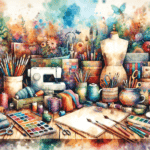This post may contain affiliate links or ads and we may earn a small commission when you click on the links at no additional cost to you. As an Amazon Affiliate, we earn from qualifying purchases. This is at no additional cost to you and helps with our website expenses.
Setting SMART goals for artists can be a transformative practice for your creative journey.
By using the SMART framework—Specific, Measurable, Achievable, Relevant, and Time-bound—you establish clear paths towards your artistic achievements.
Whether you aim to complete a series of paintings, improve your technical skills, or build a stronger online presence, this method helps you define your objectives in a structured manner that is conducive to success.
SMART Goals for Artists
As an artist, it’s easy to get lost in the creative process and lose sight of your long-term vision.
By applying SMART goals, you give yourself a set of benchmarks to gauge your progress. Instead of feeling overwhelmed by the magnitude of your dreams, you break them down into smaller, manageable tasks.
This not only makes your aspirations more attainable but also keeps you motivated as you tick off each milestone on your list.
Moreover, setting SMART goals is about more than just outlining what you want to achieve; it’s about understanding the why behind your ambitions and aligning them with your personal values and career aspirations.
By setting up goals with intention and clarity, you create a roadmap that not only guides your artistic practice but also supports your growth and development as a creative professional.
Understanding SMART Goals for Artists
Setting SMART goals allows you to create a clear roadmap for your artistic journey, ensuring your targets are clear and attainable within a specified timeframe.
Defining SMART Goals
SMART goals for artists are strategic and well-defined objectives that follow a criterion to enhance the likelihood of success. By adhering to the SMART framework, you ensure that each goal you set is:
- Specific: Your goals are clear and precise, leaving no room for ambiguity.
- Measurable: You establish concrete criteria for tracking your progress.
- Achievable: Goals should stretch your abilities yet remain reachable.
- Relevant: Align your goals with your artistic vision to maintain focus.
- Time-bound: Every goal has a specific deadline, creating a sense of urgency.
Benefits of SMART Goals for Artists
For artists, employing SMART goals can:
- Streamline your focus and boost productivity.
- Offer a structured approach to track personal and professional growth.
- Increase your ability to meet deadlines and finish projects.
The Five Elements of SMART Goals
To fully grasp each component of a SMART goal, consider this breakdown:
- Specific: Define what you want to accomplish, why it’s important, and how you’ll achieve it.
- Measurable: Set milestones to measure progress, like exhibiting a certain number of pieces or completing a body of work.
- Achievable: Evaluate your current skills and resources and ensure your goal is attainable given these parameters.
- Relevant: Your goal should align with your values as an artist and propel you toward larger career aspirations.
- Time-bound: Choose a reasonable yet ambitious deadline for your goal to maintain momentum.
Setting Up Your Art Goals
When it comes to achieving success in your art, setting SMART goals can act as the blueprint. It’s important to define what you’re working toward and how to get there effectively.
Specific SMART Goals for Artists
Crafting art goals that are as specific as a finely pointed brush is key to painting the path of your artistic journey.
Wondering where to start? It’s all about zeroing in on what you truly want to achieve with your medium or style.
Goal 1: Master Oil Portrait Painting
- Objective: Become a maestro of oil portraits, capturing emotions and expressions like never before.
- Action Steps:
- Enroll in a specialized portraiture class to learn advanced techniques.
- Dedicate time to daily practice, focusing on different facial features and expressions.
- Dive into the history and study the works of portrait masters, absorbing their styles and techniques.
Goal 2: Create a Sculpture Series
- Objective: Design and complete a compelling series of sculptures that tell a story or express a cohesive theme.
- Action Steps:
- Sketch your ideas and plan the series, defining the theme and materials needed.
- Experiment with materials and techniques in small-scale models.
- Allocate time each week to work on the sculptures, aiming for consistency in your creative process.
Goal 3: Exhibit in Local Galleries
- Objective: Get your artwork out there! Aim to have your pieces featured in local galleries within the next year.
- Action Steps:
- Research galleries that align with your style and medium, and get to know their submission requirements.
- Prepare a portfolio of your best work, tailored to each gallery’s theme or preference.
- Network with local artists and gallery owners, attending openings and art events to make those crucial connections.
Goal 4: Develop a Signature Style
- Objective: Carve out your unique niche in the art world by developing a signature style that screams “you.”
- Action Steps:
- Experiment with different mediums, techniques, and themes to find what resonates with you.
- Seek feedback from peers and mentors to understand how your work is perceived and where it stands out.
- Consistently create and share your work, refining your approach based on your evolving artistic vision.
Goal 5: Boost Online Presence
- Objective: Transform your digital footprint into a colorful mosaic of your art, reaching more eyes and hearts.
- Action Steps:
- Update or create your artist website with a gallery, biography, and contact information.
- Engage on social media platforms by posting your work, sharing behind-the-scenes glimpses, and interacting with followers.
- Explore online art communities and platforms to showcase your work and connect with other artists and potential buyers.
Remember, the more specific your goals, the clearer your roadmap to achievement.
Whether it’s mastering a new technique, sharing your work with the world, or defining your artistic identity, each step you take is a stroke on the canvas of your career.
Measuring Artistic Progress
To track your improvement, set measurable benchmarks. This could be in terms of the number of pieces you complete, the skill level you achieve, or the feedback from mentors.
Use a table or checklist to keep track of these milestones.
Progress Tracking Table:
| Milestone | Target Date | Completion Status |
|---|---|---|
| Complete 5 portraits | May 1, 2024 | In Progress |
| Receive feedback | June 10, 2024 | Pending |
Realistic and Achievable Art Goals
Ensure your art goals are realistic and attainable. If you’re a beginner, don’t set out to have a solo exhibition in three months.
A more realistic goal might be participating in a group show or selling your first piece online. Your goals should stretch your abilities but remain within reach.
Relevance in Artistic Ambitions
For goals to be meaningful and motivational, they need to be relevant to your artistic journey. Align your ambitions with your interests and career aspirations.
If your dream is to become an illustrator, focus on developing a portfolio tailored to that industry.
Time Management and Deadlines
Good time management is essential to meeting your goals. Set deadlines for each target to keep on track. Plan your days and weeks with specific time blocks dedicated to your art goals.
This might look like setting aside two hours every evening for studio work or sketching during your morning commute.
Creating a SMART Plan of Action
To effectively reach your goals as an artist, developing a SMART plan of action is vital. This plan will guide your creative process and ensure your objectives are clear and attainable.
Step-by-Step Planning
Your first move is to outline clear steps that lead you to your goal. Keep each step specific and measurable. For instance:
- Define your artistic goal. (e.g., “I want to complete a series of ten paintings about seasons.”)
- List action items. (Identify themes, research, sketching, final artwork.)
- Assign deadlines for each phase. (Sketching by March, complete two paintings each month, etc.)
This table can serve as a model for your planning:
| Step | Timeframe | Details |
|---|---|---|
| Research | Week 1-2 | Gather materials on seasonal changes. |
| Sketching preliminary ideas | Week 3 | At least three concepts for each painting. |
| Painting | Month 2-5 | One painting every two weeks. |
| Revision and refining | Week 18-20 | Adjusting details, adding final touches. |
| Exhibition preparation | Week 21 | Framing, promotion, and setting up. |
Resource Management
Secondly, you need to consider the resources required for each step. Ask yourself:
- What materials do I need? (canvas, paint, brushes, etc.)
- How much time will each step take?
- Do I have the budget for my materials and any other costs?
Create a budget plan like this:
| Resource | Quantity | Estimated Cost |
|---|---|---|
| Canvas | 10 | $200 |
| Oil Paints | 15 tubes | $150 |
| Brushes | 5 sets | $75 |
| Varnish | 3 cans | $30 |
| Framing Services | 10 | $500 |
Monitoring Progress and Adjusting Plans for SMART Goals for Artists
Finally, regularly track your progress against your plan. If you find you’re falling behind or if unexpected challenges arise, it’s important to adjust your plan accordingly. Here’s what you can do:
- Keep a progress journal: Note the completion of each planned step and any deviations from your initial plan.
- Review regularly: Every two weeks, evaluate if your current pace aligns with your goal’s timeline.
Ideally, each review will underscore your strategy’s effectiveness or signal when to steer in a new direction. Remember that flexibility is essential; adapting your plan to reality is part of the SMART system’s strength.
Artistic Skills Enhancement
Setting SMART goals is a dynamic approach to improve your artistic skills, refining core techniques while fostering an environment for creative growth.
SMART Goals for Artists: Techniques and Creativity
Your creativity is the lifeblood of your art; it distinguishes your personal style. To enhance this, focus on:
- Exploration: Try new mediums and tools. For example:
- Watercolors
- Charcoals
- Digital tablets
- Study: Analyze the work of artists you admire. Break down their:
- Composition
- Color schemes
- Brushwork
This process is invaluable for developing your own techniques and expanding your creative boundaries.
Expanding Artistic Proficiency
Building proficiency in art is akin to increasing strength through exercise; it requires consistent practice and a willingness to challenge yourself.
- Practice Routine: Establish a daily practice schedule. Include exercises like:
- Sketching from life
- Experimenting with perspective
- Perfecting shading and highlighting
- Feedback Loop: Engage with a community or mentor to receive constructive criticism. Components of your work to seek feedback on may include:
- Line quality
- Composition accuracy
- Depth and texture
Embrace each critique as an opportunity to refine your proficiency and technique.
SMART Goals for Artists Business Strategy
As an artist, developing a solid business strategy is essential to achieve sustainable success.
This includes creating a recognizable brand, diversifying your income sources, and effectively marketing your artwork.
Building an Artistic Brand
Your artistic brand is your signature style, which makes your art distinguishable and helps you stand out in the market.
It’s a combination of your artistic voice, messaging, and the visual elements that represent your art business.
- Define Your Brand: Identify what makes your art unique. Is it your color palette, subject matter, or technique?
- Visual Consistency: Use a consistent logo and color scheme across all your social media profiles and promotional materials.
Developing Multiple Income Streams
To maximize your financial stability, consider diversifying your income streams. This can include direct sales of your artwork, licensing deals, or teaching workshops.
- Sales: Offer originals, prints, and commissioned works.
- Products: Create merchandise like t-shirts, calendars, or art books.
- Teaching: Host workshops or create online courses to share your expertise.
Marketing Your Artwork
Marketing is critical for making sales and growing your art business. Establish a strong online presence and connect with your audience.
- Social Media: Regularly update your profiles with high-quality images of your artwork, upcoming events, and behind-the-scenes content.
- Email Newsletters: Keep your subscribers engaged with updates about new work, special offers, and art show invitations.
Remember, successful art business strategy combines a distinctive brand, multiple income avenues, and robust marketing to build a prosperous career in art.
SMART Goals for Artists: Preparing for Art Exhibitions
When preparing for an art exhibition, it’s crucial to map out a timeline, create impactful pieces, and employ strategic promotion and networking to ensure a successful display.
Planning Your Exhibition Timeline
Begin by establishing a timeline that outlines key dates from the preparation phase to the exhibition day. Your timeline should include:
- Call for Entries: Mark the submission deadline for your pieces.
- Artwork Creation: Allocate sufficient time for creating your pieces.
- Submission: Note when to submit final pieces for review.
- Promotion Start: Set a date to begin marketing your exhibition.
- Setup: Choose a date for setting up your exhibition space.
- Opening Day: The big event where everything comes together.
Remember to account for unforeseen delays in your timeline and plan for contingencies.
Creating Pieces for Display
Focus on crafting pieces that resonate with your artistic vision and the theme of the exhibition. Consider the following:
- Consistency: Ensure your pieces reflect a cohesive style or theme.
- Quality: Dedicate time to refine each piece to meet exhibition standards.
- Quantity: Plan the number of pieces needed to fill your allocated space without clutter.
Creating a checklist of required materials and a schedule for each piece can keep you on track.
Promotion and Networking
Effective promotion and networking are vital for attracting visitors to your exhibition. Implement a strategy that includes:
- Press Release: Draft a compelling press release to generate media interest.
- Social Media: Regularly update your social media channels with teaser images and event information.
- Invitations: Send out personalized invitations to collectors, galleries, and the art community.
Networking at other art events and fostering connections can also drive attendance to your exhibition.
Boosting Mental and Physical Health with SMART Goals for Artists
Setting SMART goals as an artist not only advances your career but also promotes your well-being. Self-care and regular exercise are key to maintaining both mental and physical health, helping you to manage stress and fear of failure effectively.
Practicing Self-care
Self-care is essential for nurturing your mental health. It’s important to:
- Establish routines that include breaks and leisure activities to prevent burnout.
- Engage in activities you enjoy outside of your art to maintain a balanced lifestyle.
| Self-Care Activity | Benefit |
|---|---|
| Meditation | Reduces stress and enhances focus |
| Regular Sleep Schedule | Improves mood and cognitive function |
| Physical Exercise | Boosts energy levels and overall health |
| Healthy Eating | Supports physical health and boosts energy levels |
| Socializing | Enhances emotional well-being and reduces feelings of isolation |
| Time in Nature | Increases creativity and reduces anxiety |
| Hobby Participation | Encourages relaxation and personal fulfillment outside of professional art |
| Digital Detox | Reduces information overload and increases presence |
| Journaling | Facilitates self-expression and emotional processing |
| Mindful Breathing Exercises | Helps manage anxiety and improves concentration |
Remember, self-care is not a luxury; it’s a necessity that equips you to face challenges with resilience.
Incorporating Exercise into Routine
Exercise is a powerful tool that can alleviate the fear of failure and boost your overall mood. To integrate exercise into your daily routine:
- Set specific workout times that align with your most energetic parts of the day.
- Choose activities that you find enjoyable, which increases the likelihood of consistency.
- Short walks or stretches between work sessions can significantly improve your physical health and mental clarity.
Regular physical activity can help you approach your artistic endeavors with a clear mind and a healthy body.
SMART Goals for Artists: Leveraging Online Platforms
When pursuing SMART goals as an artist, online platforms offer vital tools for development and exposure. Here are specific strategies to effectively use these digital spaces.
Utilizing Social Media
Create and maintain social media profiles to showcase your art, process, and progress. Utilizing platforms like Instagram, Twitter, and Pinterest allows you to build a following and engage directly with your audience.
- Instagram: Share high-quality images of your work and use relevant hashtags to reach potential followers.
- Twitter: Engage with the art community by participating in discussions and sharing thoughts on your artistic journey.
- Pinterest: Create themed boards to categorize different styles or mediums of your work and attract niche audiences.
Remember to post regularly and keep your content aligned with your artistic voice to maintain a cohesive and attractive online presence.
Online Art Tutorials and Workshops
Capitalize on online art tutorials and workshops to learn new techniques and share your expertise. Participating in or conducting these sessions can build your reputation as a knowledgeable artist and a willing learner.
- Tutorials: Consume tutorials to expand your skill set and stay updated with the latest art trends.
- Workshops: Offer workshops to establish yourself as an expert in a particular medium or style. This can be done through video platforms like YouTube or art community websites.
Incorporate what you’ve learned into your art, and don’t hesitate to write articles to document your experience or to guide others.
This provides value to the community and further cements your online presence.
Long-Term Vision and SMART Goals for Artists
Your long-term vision sets the stage for what you aspire to achieve in your artistic journey. It’s a guiding star that shapes both your current projects and future endeavors.
Now, let’s break down how you can set and maintain a course toward your artistic success.
Setting and Reviewing Long-Term Objectives
To crystallize your long-term vision, it’s crucial to establish specific objectives. Begin by asking yourself what you want to be recognized for in five to ten years.
Write a vision statement that encapsulates these aspirations. For instance, you might aim to:
- Exhibit your work in renowned art galleries
- Develop a distinctive art style that’s unmistakably yours
- Build a sustainable career in the arts
Once you have your long-term objectives outlined, create a checklist to review progress.
Revisit this checklist bi-annually to assess how well your actions align with your vision. Adjustments may be necessary to stay on track.
Aligning Short-Term SMART Goals for Artists with Long-Term Vision
Achieving your vision is a cumulative process. Start by breaking down long-term objectives into manageable short-term goals. These could include:
- Completing a series of paintings each quarter
- Attending workshops to refine your technique
- Networking with artists and curators
Ensure every goal is SMART (Specific, Measurable, Achievable, Relevant, Time-bound). This helps you make steady progress in your artistic pursuits, with a clear understanding of how each step brings you closer to your overarching vision.
Keep a table to track these SMART goals like so:
| Goal | Specific | Measurable | Achievable | Relevant | Time-bound |
|---|---|---|---|---|---|
| Complete painting series | 6 nature-inspired paintings | 6 finished pieces | Yes, with proper scheduling | Enhances portfolio for galleries | By end of Q2 |
Consistently aligning your short-term goals with your long-term vision ensures that every brushstroke contributes to the masterpiece of your career.
Practical Tips for SMART Goals for Artists Achievement
To effectively accomplish your artistic aspirations, it’s essential to navigate common obstacles and emphasize the quality of your output.
Here are some focused strategies to support you in launching new projects and sustaining your creativity without succumbing to the fear of failure.
Overcoming the Fear of Failure
One key to success is accepting that setbacks are a natural part of growth. Use the following suggestions to boost your resilience:
- Reframe Thoughts: Treat failures as learning opportunities. Ask yourself, What can I learn from this? instead of fearing what went wrong.
- Set Realistic Expectations: Break large goals into smaller, attainable tasks. Celebrate each accomplishment to foster a sense of progress.
Quality Versus Quantity
It’s tempting to think more work means better results, but this isn’t always true for artists. Prioritize the following to ensure quality shines through:
- Focused Practice: Dedicate time to refining a specific skill rather than trying to improve everything at once.
- Selective Projects: Chart out your projects and align them with your strengths. See the table below for an idea of how to balance your workload:
| Project Type | Time Allocation | Focus Area |
|---|---|---|
| Experimentation | 25% | Exploring new ideas |
| Skill Refinement | 50% | Improving techniques |
| Completion | 25% | Finalizing pieces |
Maintaining a Consistent Art Practice
The key to a meaningful portfolio is a steady practice. Incorporate these habits into your daily routine:
- Scheduled Sessions: Block out specific times each day or week exclusively for your art. Treat these as non-negotiable appointments.
- Process Documentation: Keep a log of your progress. This keeps you accountable and provides a record of your evolving style and technique.
Wrapping It Up: SMART Strategies for Artistic Success
In conclusion, setting SMART goals for artists isn’t just about enhancing your craft; it’s about creating a sustainable, fulfilling journey in the art world.
By being Specific, Measurable, Achievable, Relevant, and Time-bound in your objectives, you pave a clear path toward growth, mastery, and well-being.
Remember, blending ambition with self-care ensures you not only reach your artistic goals but enjoy the journey along the way. Keep painting your future, one SMART goal at a time!











